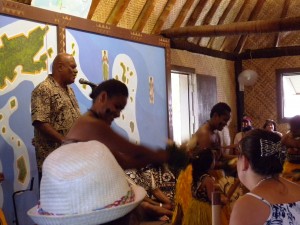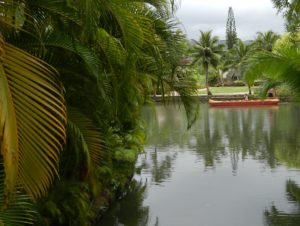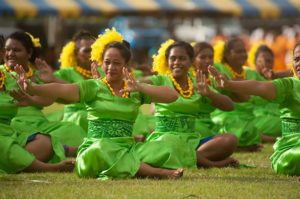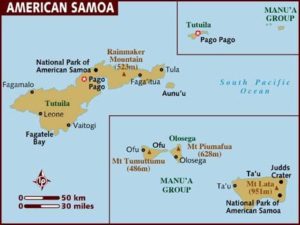» posted on Thursday, July 14th, 2022 by Linda Lou Burton
You Must Remember This
Originally Published July 17, 2020 by Linda Lou Burton posting about American Samoa from Little Rock, Arkansas – On June 23, 2012, I was at the Polynesian Cultural Center on the island of Oahu, Hawaii, with my granddaughter, who was 10. Here’s how it went:
 They found a place for Kayla and me on the back row of the jam-packed Fiji hut, and there we sat, bamboo sticks in hand, learning to chant and sing Fiji style. And, learning how to remember. The presentation at the Fiji settlement in the Polynesian Cultural Center was titled “History through Chants & Dance” and we’d just been taught how, as a group, to beat out rhythms, “one-two one-two-three” then “one-two-three-four” fast and slow, stop; then a call to us, “moo-oo” then our response “mai-ii” and repeat; somehow the roomful of us managed to do this together; and somehow, the feel of it began to stick in our memories.
They found a place for Kayla and me on the back row of the jam-packed Fiji hut, and there we sat, bamboo sticks in hand, learning to chant and sing Fiji style. And, learning how to remember. The presentation at the Fiji settlement in the Polynesian Cultural Center was titled “History through Chants & Dance” and we’d just been taught how, as a group, to beat out rhythms, “one-two one-two-three” then “one-two-three-four” fast and slow, stop; then a call to us, “moo-oo” then our response “mai-ii” and repeat; somehow the roomful of us managed to do this together; and somehow, the feel of it began to stick in our memories.
Our narrator explained the value of learning by chanting: “we had no written language until recent times, so stories and our history were passed down orally. Family is very important in our culture, and children are taught from the beginning about their ancestors,” he continued. “My 10-year old son can recite our family genealogy for 17 generations.”
Kayla and I exchanged glances, startled. Seventeen generations?
 The Polynesian Cultural Center – rated the top tourist attraction in Hawaii, is a non-profit organization operated by the LDS church. It is a family place with pleasant walkways and waterways meandering through 42 acres of Polynesian “settlements” representing Samoa, New Zealand (Aotearoa-Maori), Fiji, Hawaii, Tahiti, Tonga, and Easter Island (Rapa Nui). Its purpose is simply to preserve the culture of Polynesia. It’s all about remembering.
The Polynesian Cultural Center – rated the top tourist attraction in Hawaii, is a non-profit organization operated by the LDS church. It is a family place with pleasant walkways and waterways meandering through 42 acres of Polynesian “settlements” representing Samoa, New Zealand (Aotearoa-Maori), Fiji, Hawaii, Tahiti, Tonga, and Easter Island (Rapa Nui). Its purpose is simply to preserve the culture of Polynesia. It’s all about remembering.
As I planned my 2020 RTW stops in Hawaii, American Samoa, and New Zealand, I thought back to that day, and how little I really know of Polynesian culture. I’d planned to remedy that somewhat today as I explored the National Park of American Samoa, which of course is closed due to COVID-19, but I’ll share some facts from their website, https://www.nps.gov/npsa
 The Samoan culture is Polynesia’s oldest. We believe the first people of the Samoan Islands came by sea from southwest Asia some 3,000 years ago. Over the centuries, distinct cultural traits emerged that we now call fa’asamoa (fah-ah-SAH-mo-ah). From Samoa seafaring explorers and settlers journeyed to other Polynesian island groups hundreds of miles away.
The Samoan culture is Polynesia’s oldest. We believe the first people of the Samoan Islands came by sea from southwest Asia some 3,000 years ago. Over the centuries, distinct cultural traits emerged that we now call fa’asamoa (fah-ah-SAH-mo-ah). From Samoa seafaring explorers and settlers journeyed to other Polynesian island groups hundreds of miles away.
Follow the Fa’a Samoa —The Samoan Way
Alofa and Afio Mai! — Hello and Welcome — with some tips for pleasant visits to the villages of the islands.
- Always ask villagers for permission before taking photographs, using the beach, or engaging in other activities, however unobtrusive your actions may seem. Permission will almost certainly be granted.
- Sunday is the day for church, rest, and especially for quiet around the villages. Activities that are acceptable on other days, such as swimming, may not be permitted on Sunday.
- In a traditional home, called a fale (fah-LAY), sit down on the floor before talking, eating, or drinking. Cross your legs or pull a mat over them; it is impolite to stretch out your legs uncovered.
- Do not eat or drink while walking through a village.
- Each evening around dusk, villagers observe a time for prayers called Sā. If you are entering a village during Sā, stop and wait quietly until Sā ends. You may even be invited to join in a family prayer. It is not necessary to stop for Sā on the main roads.
- It is considered an honor to be asked to share ‘ava (a local drink made from the root of the pepper plant). To show respect, spill a few drops on the ground or mat in front of you, then raise your cup and say manuia (mahn-WE-ah) before drinking.
 The ONLY US National Park south of the equator, the National Park of American Samoa’s 13,500 acres are distributed across three islands: Tutuila, Ofu, and Ta‘ū. Its purpose is to preserve and protect coral reefs, tropical rainforests, fruit bats, and most importantly, Samoan culture. Part of the US National Park System since October 31, 1988, it is unusual in that the NPS does not own the Park lands, but entered into a 50-year lease with Samoan village councils.
The ONLY US National Park south of the equator, the National Park of American Samoa’s 13,500 acres are distributed across three islands: Tutuila, Ofu, and Ta‘ū. Its purpose is to preserve and protect coral reefs, tropical rainforests, fruit bats, and most importantly, Samoan culture. Part of the US National Park System since October 31, 1988, it is unusual in that the NPS does not own the Park lands, but entered into a 50-year lease with Samoan village councils.
Twenty-nine states have national parks, as do the territories of the US Virgin Islands, and American Samoa. There are currently 62 parks in system, with this mission: “to preserve unimpaired the natural and cultural resources and values…for the enjoyment, education, and inspiration of this and future generations.”
It’s all about remembering.
Pass It Forward https://capitalcitiesusa.org/?p=2365
Want Me To Jump? https://capitalcitiesusa.org/?p=2383
